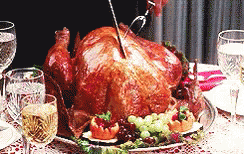Self-Taught Lesson #3: Tastes just like chicken (in a good way)
We're breaking down the elements of cooking poultry
Because I like a challenge, I signed up to cook a turkey for my immediate family’s Thanksgiving. Good to know what you’re doing right? So today is my quick dive of research into what the HECK I’m supposed to do this week.
I’m happy to say that we already have the turkey thawing and plan to dry-brine it today (read: salt the heck out of the turkey skin).
So I’m not totally blind here, but there may be a cold bath in order to thaw our turkey out later today.
While I play the waiting game with the turkey, here are the basics on cooking poultry. Primarily chicken and turkey. I’m not at a place in my life to review quail procedures.
Today’s experts are Mark Bittman’s How to Cook Everything and the classic, Joy of Cooking (2019 edition). The Brooklyn Public Library is gonna have to pry Joy out of my cold turkey hands.
Chicken is a fickle bird.
It’s fundamental in our lexicon for something tasty just average. Growing up in the early aughts was full of little quips about “mmm tastes like chicken!” when some sitcom character accidentally ate their best friend’s toe or something equally Disney Channel absurd.
Because of the blank flavor profile of a chicken breast, you can add chicken to a vegetarian meal and cross protein off your list. Chicken thigh is really where it’s at, but obviously with good flavor comes some bad fats, and such is life.
Light vs Dark Chicken Parts
If some of this is repeat knowledge for me, it may also be repeat knowledge for you. Yes, chicken breasts are lighter, “healthier” meat. Thighs are fattier and delicious but not something you should cook every day because of darker meat.
But do we know, inherently, what is the best way to prepare a chicken thigh vs a chicken breast? I don’t!
This is a quick breakdown of temperatures and parts. Once you’re equipped with the ingredient, you’ll know what the best technique is for whatever part you’ve chosen.
What kind of chicken should I buy?
Natural effectively means nothing. Any chicken can be labeled as natural, but that doesn’t mean that it doesn’t have antibiotics in it.
Heirloom or heritage breed chickens have darker meat and tend to live on farms (larger legs, smaller breasts). Since there’s lots of dark meat, there’s lots of flavor.
Specialty or locally raised: these are the highest quality, and most expensive, chicken types. These overlap with “heritage breed” chickens.
If you’re looking to shop local, check out a local farmer’s market, natural food stores, or other farms
Free-range or free-roaming chickens = chickens get outside. That’s it. The chickens could be eating gravel in a 5x5 cube, but the sticker is the same. This doesn’t guarantee quality.
Organic poultry is raised without antibiotics and fed with organic feed that doesn’t have animal byproducts or engineered grains
Air-chilled poultry is left in cold air after being slaughtered (instead of cold water)
Water-chilled poultry takes on some of the water and can be a little less flavorful for this step
Basted or self-basting chickens are chickens that come to you ready to douse themselves with additional liquid as they cook (usually containing salt, broth, fat). This might alter their textures, potentially for the worst.
Kosher and halal: these chickens are prepared by Jewish or Islamic law. Kosher chickens per Jewish tradition must be free of illness or injury and killed by a shechita. The bird is then bled out and salted to draw more blood. Halal chickens, according to Islamic tradition, also have their throats slit and bleed out, but they do not have to be salted as Kosher chickens do. These birds are typically available near bigger cities as a frozen option, and they may be more expensive than a supermarket chicken, but the quality may be higher.
What temperature should I cook the chicken at?
The first step here is buying a meat thermometer to double check the temperatures. This is something you can’t eyeball.
Keep reading with a 7-day free trial
Subscribe to self-taught to keep reading this post and get 7 days of free access to the full post archives.





